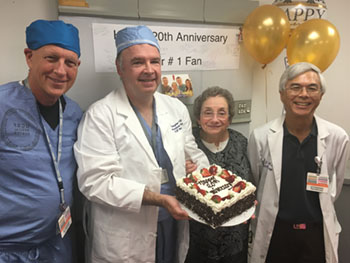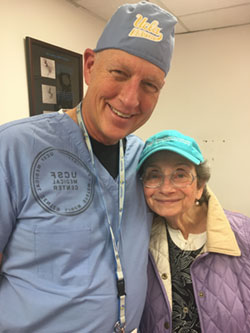Celebration of Life: 20 Years after Life-Saving Procedure, Patient Honors Care Team
 Author: Laurel Skurko, Former Marketing Director, UCSF Radiology and Biomedical Imaging
Author: Laurel Skurko, Former Marketing Director, UCSF Radiology and Biomedical Imaging
Picture a tidy, humble medical center conference room brightened by a pink tablecloth, two inviting bakery cakes, and a freshly opened box of chocolates. You’ve probably seen something like this before--maybe it’s a birthday, or a small retirement event. Neither the decorations nor the attendees provide a clear indication of what the party commemorates. Nearly everyone in attendance is attired in the white coats of the medical profession, but they are not the center of attention. That focus falls on a petite and no longer young woman whose energy and lightness of heart suggest she’s a little above the ordinary.
What exactly is going on? It’s a thank you party, and not just any thank you party, but a full-blown, no-holds-barred, heartfelt gratitude celebration. The party is co-hosted by Elaina Rose Lovejoy, that woman in the center with the contagious energy, and it’s a celebration for the team she credits “big time” with having saved her life twenty years ago.
Every year leading up to this one, Lovejoy has sent gifts and a thank you card to the medical team that performed what was some thought of as a “parlor trick,” inserting image-guided platinum coils through an artery to eliminate an aneurysm threatening her brain. Like clockwork, she does this every May and every December. This year, just as she did 10 years ago at this time, she wanted to express her gratitude to them in person.
Twenty years ago, Lovejoy knew something was wrong. She’d escaped what she describes as a “disastrous” marriage and landed in Berkeley in the late 1960s, to earn a doctorate from UC Berkeley. Later, she was invited by St. Mary’s college to co-found the department of education, where she has been teaching since 1971 (45 years!). In 1995, she began experiencing vision problems and a mysterious pressure behind her left eye. She asked her physician to refer her for an MRI but he refused saying, it was only optic neuritis.
After experiencing six months of being misdiagnosed, and with continuing decline in vision, she found a neuro-opthamologist. “I told that doctor, ‘Something is terribly wrong. Please, you have to believe me.’ And he gave this slight tilt of his head, and said, ‘I do.’ That started the process that sent me to UCSF.” Coincidentally, the doctor who had originally misdiagnosed Lovejoy heard about the results regarding the aneurysm diagnosis, and he said, “At UCSF, they’re doing a new procedure with coils to treat brain aneurysms. Don’t get the coils.”
The technique they were using at UCSF was, in fact, a new one, but for interventional neuroradiologist Randall Higashida, MD, that was not reason enough to say no to the potentially lifesaving procedure.
 “The technique had only been out for a few years. We were among the first ten centers in the country to be invited to perform it,” describes Dr. Higashida. “At UCSF, we always want to be part of embracing new technologies, but safely and carefully. We proceed slowly, as you would want someone to do. By the time Elaina’s appointment was made, we had done a few procedures and were ready for the potential challenges that could arise.”
“The technique had only been out for a few years. We were among the first ten centers in the country to be invited to perform it,” describes Dr. Higashida. “At UCSF, we always want to be part of embracing new technologies, but safely and carefully. We proceed slowly, as you would want someone to do. By the time Elaina’s appointment was made, we had done a few procedures and were ready for the potential challenges that could arise.”
Christopher Dowd, MD, was part of Lovejoy’s care team those many years ago. Today he says, “As doctors, we are gratified by what we do, but we don’t really go around saying, ‘What a good job we’ve done.’ We mostly find ourselves moving on to the next case. We don’t expect or feel like we deserve praise, though, of course, like any human being, we really appreciate it!” In the conference room in the present day, when Lovejoy recalls the moment of being taken in for surgery and asking Dr. Dowd for his moral support, their eyes meet and they share a memory of a powerful, life-changing moment that neither of them has forgotten.
Lovejoy purposefully planned the gathering as a moment for the Dowd, Higashida, Van Halbach, MD, and the rest of the care team (who still collaborate on cases to this day) to pause and reflect on the work they did two decades ago. “I can’t pay you back--I have to pay you forward,” she tells them. “I was allowed to keep teaching and being a grandma into my elder years because of you. My gratitude for you is ever-present.” Lovejoy and her family will be celebrating her 80th birthday this August. She plans to retire from St. Mary’s College next year. She gives credit to UCSF and the Neuro Interventional team for making this possible.
